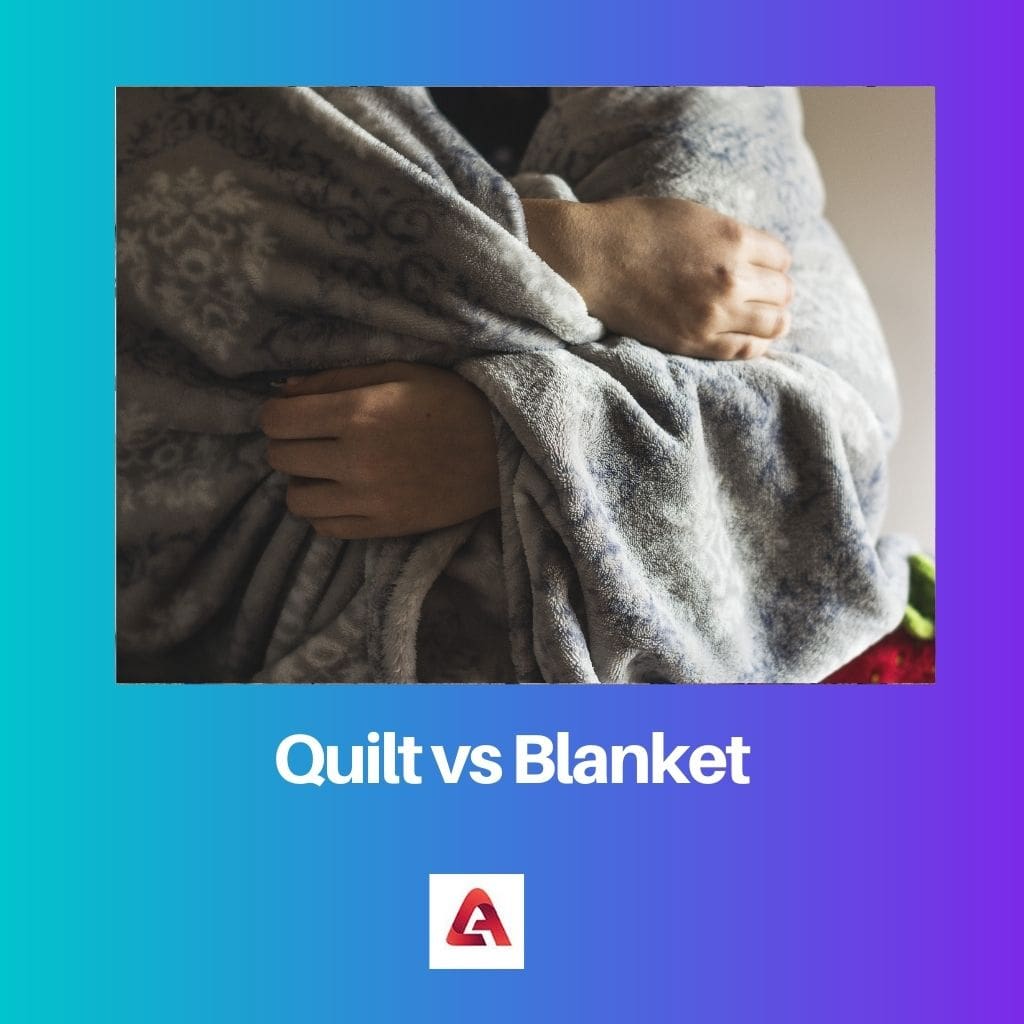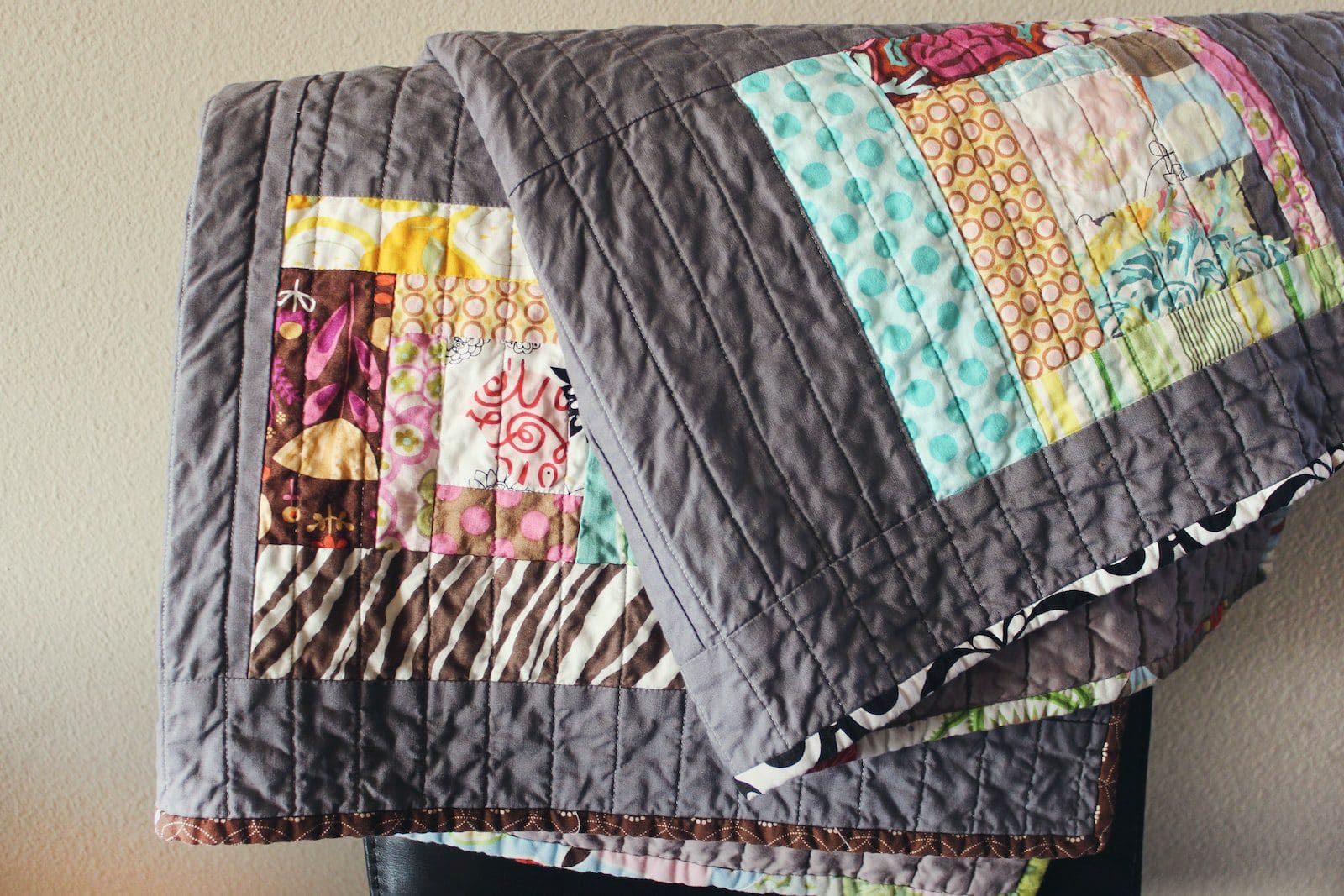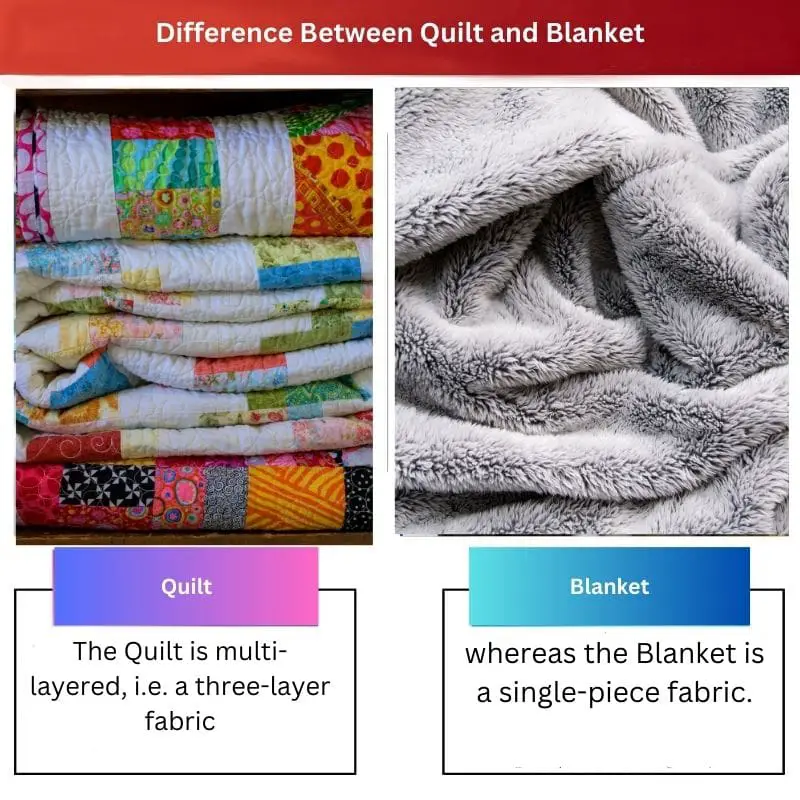A quilt is a multi-layered textile composed of a decorative top layer, a middle layer of batting, and a backing material, stitched together in intricate patterns, providing warmth and aesthetic appeal. On the other hand, a blanket is a single-layered covering made of various materials, such as fleece, wool, or cotton, primarily designed for warmth and comfort without the decorative stitching found in quilts.
Key Takeaways
- Quilts are made by sewing together multiple layers of fabric with a filling in between, while blankets are made from a single layer of fabric or material.
- Quilts are warmer and more durable than blankets and can be used for decorative purposes, while blankets are lighter and more versatile.
- Quilts are more expensive and time-consuming than blankets, which can be mass-produced.
Quilt vs Blanket
The difference between Quilt and a Blanket is that a Quilt has three layers, i.e. top, middle batting, and bottom. Different pieces of fabric are stitched to give a complex pattern to the top layer of the Quilt. A Blanket comprises a single type of fabric such as fleece, cashmere, polyester, acrylic, cotton, wool, or a blend of polyester & cotton, which is woven with a loom.

The middle layer of batting is made of wool in a quilt, and the bottom is made from a solid fabric. All three Quilt layers are stitched to make it one single piece.
Generally, wool is widely used to make blankets, making them warmer and thicker.
Comparison Table
| Feature | Quilt | Blanket |
|---|---|---|
| Construction | Patchwork of fabric pieces sewn together, with batting in between | Single layer of fabric, sometimes with filling or padding |
| Warmth | Varies depending on thickness and materials, can be very warm | Typically lighter and less warm than quilts |
| Versatility | Can be used as a bedspread, throw, wall hanging, or picnic blanket | Primarily used for covering and providing warmth on beds, couches, or while relaxing |
| Durability | Can be very durable with proper care, some quilts are heirlooms passed down generations | May wear or tear more easily, especially with frequent use |
| Maintenance | Can be more challenging to wash and dry due to patchwork and batting | Typically easier to clean and care for than quilts |
| Cost | Can range from inexpensive to very expensive depending on materials, size, and craftsmanship | Generally more affordable than quilts |
| Aesthetics | Often unique and decorative with various patterns and colors | Can be plain or patterned, but less visually striking than quilts |
| Craftsmanship | Quilting is a craft with a long history and tradition | Blankets can be handmade, but mass-produced |
| Emotional value | Quilts can be sentimental and hold personal memories | Can be associated with comfort and coziness, but less emotionally charged than quilts |
What is Quilt?
A quilt is a type of bedding or textile traditionally composed of three layers: a decorative top layer, an insulating middle layer (known as batting), and a backing material. These layers are stitched together in a process known as quilting to create a cohesive and functional piece.
Composition
- Top Layer: The top layer of a quilt is made from various fabrics, which can range from cotton and silk to polyester and denim. This layer is pieced together using different patterns, colors, and textures to create visually appealing designs.
- Batting: The middle layer, or batting, provides warmth and insulation. It is made from natural fibers like cotton, wool, or silk, or synthetic materials such as polyester. The thickness and loft of the batting determine the quilt’s warmth and weight.
- Backing Material: The backing material serves as the underside of the quilt, providing stability and structure. It is a single piece of fabric, but can also be pieced together for larger quilts. The backing fabric can be plain or patterned, depending on the desired aesthetic.
Construction
- Piecing: The process of piecing involves sewing together smaller fabric pieces to form the quilt’s top layer. This can be done using various techniques such as patchwork, appliqué, or foundation piecing, allowing for endless design possibilities.
- Quilting: Quilting refers to the stitching that holds the layers of the quilt together. This can be done by hand or using a sewing machine, and the stitches can be simple or elaborate, adding both decorative and functional elements to the quilt.
- Binding: Once the quilting is complete, binding is added to the edges of the quilt to finish it off. Binding is made from strips of fabric folded over the raw edges and sewn in place, providing a clean and durable edge.
Purpose and Use
Quilts serve both practical and aesthetic purposes. They provide warmth and comfort as bedding or throws, while also adding beauty and personality to a room’s décor. Quilts are passed down through generations as heirlooms, carrying with them memories and stories of the past.

What is Blanket?
A blanket is a large piece of fabric or covering primarily designed for warmth and comfort. It is a versatile textile used in various settings, including beds, couches, and outdoor activities, providing insulation and coziness.
Composition
- Material: Blankets can be crafted from a wide range of materials, including fleece, wool, cotton, acrylic, and polyester. Each material offers different properties such as softness, warmth, breathability, and durability, catering to diverse preferences and needs.
- Construction: Blankets are single-layered, although some may feature additional layers for added warmth or thickness. They come in various sizes and weights, ranging from lightweight throws to heavier bed blankets, offering options suitable for different climates and seasons.
Types of Blankets
- Fleece Blankets: Fleece blankets are made from synthetic materials such as polyester and are known for their softness, lightweight feel, and warmth. They are popular choices for indoor and outdoor use due to their versatility and ease of care.
- Wool Blankets: Wool blankets are crafted from natural wool fibers, prized for their excellent insulation properties, moisture-wicking abilities, and durability. They provide warmth even when wet and are favored for cold weather conditions.
- Cotton Blankets: Cotton blankets are breathable, lightweight, and suitable for use year-round. They are soft to the touch and offer a comfortable sleeping experience. Cotton blankets may come in various weaves, such as thermal, waffle, or knit, providing different textures and levels of warmth.
Purpose and Use
Blankets serve primarily to provide warmth and comfort, making them essential household items in bedrooms and living spaces. They can be used as bedding layers to enhance sleep quality, as throws for relaxation on sofas or chairs, or as wraps for outdoor activities such as picnics or camping.

Main Differences Between Quilts and Blankets
- Composition:
- Quilts consist of three layers: a decorative top layer, a middle layer of batting for insulation, and a backing material.
- Blankets are single-layered, made from various materials such as fleece, wool, or cotton.
- Construction:
- Quilts involve piecing together fabric to create intricate designs, followed by quilting stitches to secure the layers.
- Blankets are simpler in construction, with no elaborate piecing or stitching required.
- Purpose and Use:
- Quilts serve both practical and aesthetic purposes, providing warmth as bedding while also adding visual interest to a room’s décor.
- Blankets are primarily designed for warmth and comfort, serving as bedding layers, throws for lounging, or outdoor wraps for activities like camping.




